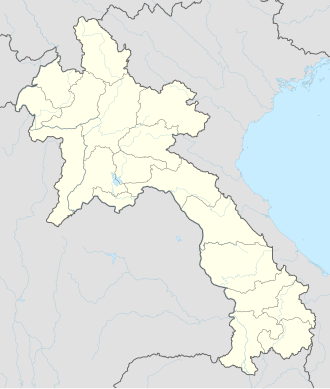Nam Ha National Protected Area
| Nam Ha National Protected Area | |
|---|---|
IUCN category VI (protected area with sustainable use of natural resources) | |
 Tham Khao Rao caves in Nam Ha NPA | |
| Location | Luang Namtha Province, Laos |
| Nearest city | Luang Namtha |
| Coordinates | 20°49′1″N 101°15′10″E / 20.81694°N 101.25278°E |
| Area | 2,224 km2 (860 sq mi) |
| Designated | 29 October 1993 |
| Visitors | 6,500 (in 2008)[1] |
| Website | www |
Nam Ha National Protected Area is a national protected area in Luang Namtha Province in northern Laos. This mostly forested park is home to a variety of ethnic groups and diverse animal and plant species.[2] The park is an ecotourism destination.[1][3]
Geography
[edit]Nam Ha National Protected Area is located about 5 km (3 mi) southwest of Luang Namtha and covers parts of all five of the province's districts. The park's area is 2,224 km2 (860 sq mi). The park encompasses the Nam Ha Important Bird Area with an area of 1,845 km2 (710 sq mi).[4]
Elevations range from about 500 m (1,640 ft) to the park's peak at 2,094 m (6,870 ft). The park incorporates three rivers which drain into the Mekong: the Nam Tha, Nam Fa and Nam Long. The Nam Tha is the Mekong's first major tributary after entering Laos.[2]
History
[edit]In 1980 Nam Ha was identified as a Provincial Protected Area. In 1993 Nam Ha National Protected Area was initially decreed to cover 697 km2 (270 sq mi). This was extended in 1999 to cover the present area of 2,224 km2 (860 sq mi).[2] In 2003 Nam Ha was designated an ASEAN Heritage Park, the only one in Laos.[5] In 2006 the Nam Ha Ecotourism Project (a joint UNESCO–Lao project to sustainably manage the park) won the Equator Prize.[1]
Flora and fauna
[edit]The park's main forest type is mixed secondary deciduous forest including secondary evergreen forest. At the park's lower elevations, in the Luang Namtha plain, human modification of the forest is evident and habitats include bamboo and scrub areas.[2]
Animal species include Assam macaque, clouded leopard, gaur, tiger, elephant and a possibly unique species of muntjac.[2][4] The frog species Amolops akhaorum is only known from the park.[6] It is named for the local Akha people who helped with the fieldwork of the team who discovered the species in 2007.[7]
The park is host to diverse bird species: about 300 species are recorded here.[2] A few species are unique in Laos to Nam Ha: crested finchbill, white-bellied redstart and white-necked laughingthrush.[4]
Threats
[edit]Nam Ha faces a number of environmental threats. The most significant is slash-and-burn agriculture. Harvesting of forest products, including timber, is also a threat. Hunting of wildlife is conducted by both residents and outsiders. Domesticated animals roam freely, disturbing wildlife and damaging wild habitats.[2] Clearance of forested land for rubber plantations has occurred.[1]
- Park forest
- Village within NPA
See also
[edit]References
[edit]- ^ a b c d "Nam Ha Ecotourism Project" (PDF). UNDP Equator Initiative. Retrieved 27 November 2014.
- ^ a b c d e f g "Nam Ha NBCA". Greater Mekong Subregion Sustainable Tourism Development Project in Lao PDR. Archived from the original on 6 January 2014. Retrieved 26 November 2014.
- ^ Ray, Nick; Bloom, Greg; Waters, Richard (February 2014). Lonely Planet Laos (8th ed.). Lonely Planet. p. 106. ISBN 978-1-7432-1825-9.
- ^ a b c "Birdlife Data Zone: Nam Ha". BirdLife International. 2003. Retrieved 5 June 2017.
- ^ "List of ASEAN Heritage Parks". ASEAN Centre for Biodiversity. Retrieved 16 March 2015.
- ^ Frost, Darrel R. (2017). "Amolops akhaorum Stuart, Bain, Phimmachak, and Spence, 2010". Amphibian Species of the World: an Online Reference. Version 6.0. American Museum of Natural History. Retrieved 14 July 2017.
- ^ Stuart, B.L.; Bain, R.H.; Phimmachak, S.; Spence, K. (2010). "Phylogenetic systematics of the Amolops monticola group (Amphibia: Ranidae), with description of a new species from northwestern Laos" (PDF). Herpetologica. 66 (1): 52–66. Archived (PDF) from the original on 2016-10-22.


 French
French Deutsch
Deutsch

